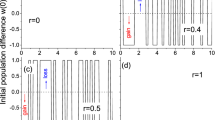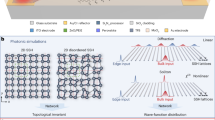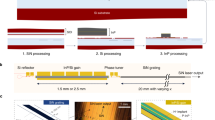Abstract
Leveraging the entire space of complex dielectric permittivity, non-Hermitian photonics has fundamentally altered wave propagation with complex optical potentials and has ushered in a host of new photonic applications. Through parity–time symmetry and its breaking—a delicate interplay between gain and loss—even the interaction between just two entities becomes counter-intuitive and intriguing. Here we realize, through hybrid III–V/Si integration, a scalable non-Hermitian switching network on a two-layer integrated photonic chip. Our platform is a hybrid, with a bottom silicon layer and a top InGaAsP layer that provides optical gain. By tuning the gain level in the top layer, vertically coupled waveguides operate below or above the exceptional point, where light is switched across two layers, among different input–output ports. For a single switching unit, the switching dynamics are ultrafast, on the order of 100 ps. In a large switching network, non-blocking and other diverse connectivities are established in single-wavelength and wavelength-selective switching, with high extinction ratios. Our approach adds scalable non-Hermitian switching to photonic design toolkits to simultaneously boost the switching time and bandwidth density to cutting-edge levels, therefore paving the way for compact and ultrafast monolithic integrated silicon photonics in next-generation optical information networks.
This is a preview of subscription content, access via your institution
Access options
Access Nature and 54 other Nature Portfolio journals
Get Nature+, our best-value online-access subscription
$32.99 / 30 days
cancel any time
Subscribe to this journal
Receive 12 print issues and online access
$259.00 per year
only $21.58 per issue
Buy this article
- Purchase on SpringerLink
- Instant access to full article PDF
Prices may be subject to local taxes which are calculated during checkout




Similar content being viewed by others
Data availability
Source data are provided with this paper. All other data that support other findings of this study are available from the corresponding author upon reasonable request.
References
Lu, L. et al. 16 × 16 non-blocking silicon optical switch based on electro-optic Mach–Zehnder interferometers. Opt. Express 24, 9295–9307 (2016).
Zhao, S. et al. 16 × 16 silicon Mach–Zehnder interferometer switch actuated with waveguide microheaters. Photonics Res. 4, 202–207 (2016).
Qiao, L., Tang, W. & Chu, T. 32 × 32 silicon electro-optic switch with built-in monitors and balanced-status units. Sci. Rep. 7, 42306 (2017).
Shen, Y. et al. Deep learning with coherent nanophotonic circuits. Nat. Photonics 11, 441–446 (2017).
Sherwood-Droz, N. et al. Optical 4 × 4 hitless silicon router for optical Networks-on-Chip (NoC). Opt. Express 16, 15915–15922 (2008).
Cheng, Q. et al. Ultralow-crosstalk, strictly non-blocking microring-based optical switch. Photonics Res. 7, 155–161 (2019).
Cheng, Z. et al. On-chip silicon electro-optical modulator with ultra-high extinction ratio for fiber-optic distributed acoustic sensing. Nat. Commun. 14, 7409 (2023).
Seok, T. J., Quack, N., Han, S., Muller, R. S. & Wu, M. C. Large-scale broadband digital silicon photonic switches with vertical adiabatic couplers. Optica 3, 64–70 (2016).
Kim, D. U. Programmable photonic arrays based on microelectromechanical elements with femtowatt-level standby power consumption. Nat. Photonics 17, 1089–1096 (2023).
Haffner, C. et al. Low-loss plasmon-assisted electro-optic modulator. Nature 556, 483–486 (2018).
Haffner, C. et al. Nano–opto-electro-mechanical switches operated at CMOS-level voltages. Science 366, 860–864 (2019).
Midolo, L., Schliesser, A. & Fiore, A. Nano-opto-electro-mechanical systems. Nat. Nanotechnol. 13, 11–18 (2018).
Wonfor, A., Wang, H., Penty, R. V. & White, I. H. Large port count high-speed optical switch fabric for use within datacenters [invited]. J. Opt. Commun. Netw. 3, A32–A39 (2011).
Stabile, R., Rohit, A. & Williams, K. A. Monolithically integrated 8 × 8 space and wavelength selective cross-connect. J. Lightwave Technol. 32, 201–207 (2014).
Davenport, M. L. et al. Heterogeneous silicon/III–V semiconductor optical amplifiers. IEEE J. Sel. Top. Quantum Electron. 22, 78–88 (2016).
Cheng, Q., Wonfor, A., Wei, J. L., Penty, R. V. & White, I. H. Monolithic MZI–SOA hybrid switch for low-power and low-penalty operation. Opt. Lett. 39, 1449–1452 (2014).
Konoike, R. et al. SOA-integrated silicon photonics switch and its lossless multistage transmission of high-capacity WDM signals. J. Lightwave Technol. 37, 123–130 (2019).
Matsumoto, T. et al. Hybrid-integration of SOA on silicon photonics platform based on flip-chip bonding. J. Lightwave Technol. 37, 307–313 (2019).
Feng, L., El-Ganainy, R. & Ge, L. Non-Hermitian photonics based on parity–time symmetry. Nat. Photonics 11, 752–762 (2017).
Zhao, H. et al. Non-Hermitian topological light steering. Science 365, 1163–1166 (2019).
Liao, K. et al. On-chip integrated exceptional surface microlaser. Sci. Adv. 9, eadf3470 (2023).
El-Ganainy, R., Makris, K. G., Christodoulides, D. N. & Musslimani, Z. H. Theory of coupled optical PT-symmetric structures. Opt. Lett. 32, 2632–2634 (2007).
Guo, A. et al. Observation of \(\mathcal{P}\mathcal{T}\)-symmetry breaking in complex optical potentials. Phys. Rev. Lett. 103, 093902 (2009).
Rüter, C. E. et al. Observation of parity–time symmetry in optics. Nat. Phys. 6, 192–195 (2010).
Ge, L., Makris, K. G. & Zhang, L. Optical fluxes in coupled \(\mathcal{P}\mathcal{T}\)-symmetric photonic structures. Phys. Rev. A 96, 023820 (2017).
Deng, H. & Khajavikhan, M. Parity–time symmetric optical neural networks. Optica 8, 1328–1333 (2021).
Moiseyev, N. Non-Hermitian Quantum Mechanics (Cambridge Univ. Press, 2011).
Zhang, Z. et al. Ultrafast control of fractional orbital angular momentum of microlaser emissions. Light Sci. Appl. 9, 179 (2020).
Sun, B. Q., Gal, M., Gao, Q., Tan, H. H. & Jagadish, C. On the nature of radiative recombination in GaAsN. Appl. Phys. Lett. 81, 4368–4370 (2002).
Uzdin, R., Mailybaev, A. & Moiseyev, N. On the observability and asymmetry of adiabatic state flips generated by exceptional points. J. Phys. A 44, 435302 (2011).
Doppler, J. et al. Dynamically encircling an exceptional point for asymmetric mode switching. Nature 537, 76–79 (2016).
Goldzak, T., Mailybaev, A. A. & Moiseyev, N. Light stops at exceptional points. Phys. Rev. Lett. 120, 013901 (2018).
Moiseyev, N. & Šindelka, M. Transfer of information through waveguides near an exceptional point. Phys. Rev. A 103, 033518 (2021).
Liao, K. et al. Spintronics of hybrid organic–inorganic perovskites: miraculous basis of integrated optoelectronic devices. Adv. Opt. Mater. 7, 1900350 (2019).
Roelkens, G. et al. III–V/silicon photonics for on‐chip and intra‐chip optical interconnects. Laser Photon. Rev. 4, 751–779 (2010).
Fang, A. W. et al. Electrically pumped hybrid AlGaInAs-silicon evanescent laser. Opt. Express 14, 9203–9210 (2006).
Liang, D., Huang, X., Kurczveil, G., Fiorentino, M. & Beausoleil, R. G. Integrated finely tunable microring laser on silicon. Nat. Photonics 10, 719–722 (2016).
Huang, D. et al. High-power sub-kHz linewidth lasers fully integrated on silicon. Optica 6, 745–752 (2019).
Acknowledgements
We acknowledge support from the Army Research Office (ARO) (W911NF-21-1-0148 and W911NF-22-1-0140), the Office of Naval Research (ONR) (N00014-23-1-2882) and the National Science Foundation (NSF) (ECCS-2023780, DMR-2117775, DMR-2326698 and DMR-2326699). This work was carried out in part at the Singh Center for Nanotechnology, which is supported by the NSF National Nanotechnology Coordinated Infrastructure Program under grant no. NNCI-1542153.
Author information
Authors and Affiliations
Contributions
L.F. and X.F. designed the experiment. X.F., T.W., Z.G., L.G. and L.F. designed the photonic switch. X.F., T.W. and L.G. constructed the theoretical model. X.F. performed numerical simulations and fabricated the sample. X.F., T.W., Z.G., H.Z. and Y.Z. performed the measurements. X.F. and S.W. performed the data processing. X.F., S.W., L.G. and L.F. prepared the manuscript. All the authors contributed to the discussions.
Corresponding author
Ethics declarations
Competing interests
The authors declare no competing interests.
Peer review
Peer review information
Nature Photonics thanks the anonymous reviewers for their contribution to the peer review of this work.
Additional information
Publisher’s note Springer Nature remains neutral with regard to jurisdictional claims in published maps and institutional affiliations.
Extended data
Extended Data Fig. 1
Fabrication flow of the III-V/Si hybrid photonic switch.
Extended Data Fig. 2 Schematic of experimental setup.
Blue line: pump beam. Red line: signal beam. ND: neutral density. HWP: half-wave plate. PBS: polarizing beamsplitter. BPF: bandpass filter. FM: flip mirror. BS: beamsplitter. SPAD: single photon avalanche diode.
Supplementary information
Supplementary Information
Supplementary Figs. 1–14 and discussion.
Source data
Source Data Fig. 2
Source data for Fig. 2b–d.
Source Data Fig. 3
Source data for Fig. 3e–g.
Source Data Fig. 4
Source data for Fig. 4b–e.
Rights and permissions
Springer Nature or its licensor (e.g. a society or other partner) holds exclusive rights to this article under a publishing agreement with the author(s) or other rightsholder(s); author self-archiving of the accepted manuscript version of this article is solely governed by the terms of such publishing agreement and applicable law.
About this article
Cite this article
Feng, X., Wu, T., Gao, Z. et al. Non-Hermitian hybrid silicon photonic switching. Nat. Photon. 19, 264–270 (2025). https://doi.org/10.1038/s41566-024-01579-9
Received:
Accepted:
Published:
Issue date:
DOI: https://doi.org/10.1038/s41566-024-01579-9
This article is cited by
-
Artificial gauge fields in photonics
Nature Reviews Physics (2025)
-
Field-programmable photonic nonlinearity
Nature Photonics (2025)
-
Optoelectronic interconnection applications from growth-based monolithic in-plane integration of CsPbBr3 nanowire arrays with CdSSe nanoribbon trunks
Science China Materials (2025)



